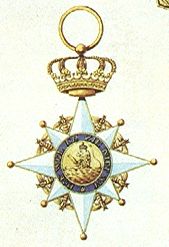Union Order
The order of the union ( nl. : Koninglijke Orde van de Unie ) was an order of merit for military and civilians and was in 1806 by Louis Napoleon donated. It was an order of the newly created Kingdom of Holland and was briefly called the Royal Order of Holland . After 1811 the order became a French award. Napoleon dissolved the order after the annexation of Holland. Some merits were accepted into the Legion of Honor , for others Napoleon created the French Order of Reunification ( Ordre impérial de la Réunion ) in 1811 , where a certain number of awards were reserved for Dutch people, but this was hardly ever awarded.
history
On the day of his arrival in The Hague , June 6, 1806 , the newly appointed King of Holland Lodewijk I donated two orders: the "Great Order of Holland" ( Grote Orde van Holland ), which was supposed to be one class, and an Order of Merit, the Koninglijke Orde van Merit , which should have only two classes, that of commanders and knights (according to other information: three classes , commanders, knights and squires ). For the “Great Order” Lodewijk I chose the motto L'union fait notre force ( Unity makes us strong , still today, in a slightly different form, motto of the Kingdom of Belgium ). The unauthorized act in Napoleon's eyes provoked an angry reaction from the imperial brother, because his great French empire had only one distinction, the Legion of Honor , and his kingdom of Italy, which was much larger than Louis Holland, had only one three-class medal, the Iron Crown , and the Kaiser forced Ludwig to cancel the foundation. The "Grand Order" was not given to anyone, and the Order of Merit only existed until February 1807 . At the beginning of 1807, Ludwig issued new statutes in which the two orders were combined into a new distinction, the three-class "Royal Order of Holland" ( Koninglijke Orde van Holland ). Already in November 1807 the order was renamed again and carried the name "Royal Order of the Union" until February 1808 , was renamed the "Royal Order of the Union of Holland" in the same month, and finally during the last three years of its existence until 1811 to be called "Royal Order of the Union" again.
Order classes
The order had three classes and the king was a grand master.
Order decoration
The medal decorations were the medal, an eight-pointed gold star, covered on both sides with white enamel , the breast star of the 1st class and the collar . The medallion the front of the religious character was until 1807 the bust of the founder , which was surrounded by an inscription "Lodewijk I Koning van Holland". In later versions of the medal, the image of the king was exchanged for a lion lying on the seashore (formerly seen on the back of the medal). This lying lion was depicted on the back of the medal until around 1808 , surrounded by the text of the final motto of the order Doe wel en zie niet om . The motto means "do right and don't look around". The last model of the medallion had a bundle of rays in the medallion on the reverse, early examples from the time when the award was called "Order of Merit" show a striding Dutch lion on the reverse. Golden bees , one of the symbols of the first French empire, were placed between the rays of the medal . The order decoration hung on a golden royal crown .
The breast star of the 1st class was silver, with eight longer and fourteen shorter rays, and carried in its center the medallion with the lion lying by the sea, which was surrounded by the above motto.
The collar consisted of 26 links, 13 plaques with the coat of arms of the Dutch departments and 13 plaques with bundles of rays. The medal was also awarded with diamonds .
Ribbon and way of wearing
The ribbon was light blue and the holders of the Grand Cross wore the award on a sash over the right shoulder to the left hip. The second class put the medal around the neck, while the knights fixed the medal in the buttonhole or on the left breast.
Trivia
Because of the bee on the medal, the order is also called the Order of the Bee .
literature
- Gustav Adolph Ackermann, Order book of all orders flourishing and extinct in Europe , Annaberg 1855
- Oekonomische Encyklopädie , Johann Georg Krünitz, Friedrich Jakob Floerken, Heinrich Gustav Flörke , Johann Wilhelm David Korth, Carl Otto Hoffmann, Ludwig Kossarski, published 1848

